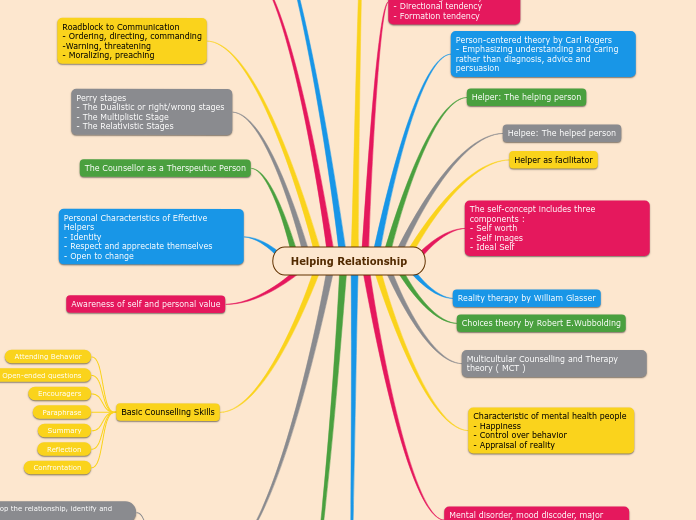Helping Relationship
Helping relationship will help individual to motivate themselves and deal with stressful situations. Helping relationship is important interventions for individual’ growth.
Helping relationship will help individual to motivate themselves and deal with stressful situations. Helping relationship is important interventions for individual’ growth.
The Three Natural Tendencies
- Actualizing tendency
- Directional tendency
- Formation tendency
Person-centered theory by Carl Rogers
- Emphasizing understanding and caring rather than diagnosis, advice and persuasion
Helper: The helping person
Helpee: The helped person
Helper as facilitator
The self-concept includes three components :
- Self worth
- Self images
- Ideal Self
Reality therapy by William Glasser
Choices theory by Robert E.Wubbolding
Multicultular Counselling and Therapy theory ( MCT )
Characteristic of mental health people
- Happiness
- Control over behavior
- Appraisal of reality
Mental disorder, mood discoder, major depressive disorder
Attributes of mental health
- Thinking
- Behavior
- Interpersonal Relationship
Different Emphases Between Psychotherapy, Counselling, Interviewing, and Coaching
Coaching : A strong from of encouragement
Psychotherapy : More emphasis on the pathology and accurate diagnosis
Interviewing : More emphasis on gaining information. Information may be use to help other person rather than the client.
Counselling : More emphasis on the therapeutic relationship and overcoming normal development hurdles. Growth-oriented
1. Non-professionals
2. Paraprofessionals
3. Professional
Roadblock to Communication
- Ordering, directing, commanding
-Warning, threatening
- Moralizing, preaching
Perry stages
- The Dualistic or right/wrong stages
- The Multiplistic Stage
- The Relativistic Stages
The Counsellor as a Therspeutuc Person
Personal Characteristics of Effective Helpers
- Identity
- Respect and appreciate themselves
- Open to change
Awareness of self and personal value
Basic Counselling Skills
Attending Behavior
Close and Open-ended questions
Encouragers
Paraphrase
Summary
Reflection
Confrontation
Dasie model
Stage 1: Develop the relationship, identify and clarify problem
Stage 2: Assess problem and redefine in skills terms
Stage 3: State working goals and plan interventions
Stage 4: Intervene to develop self-helping skills
Stage 5: End and consolidate self-helping skills
